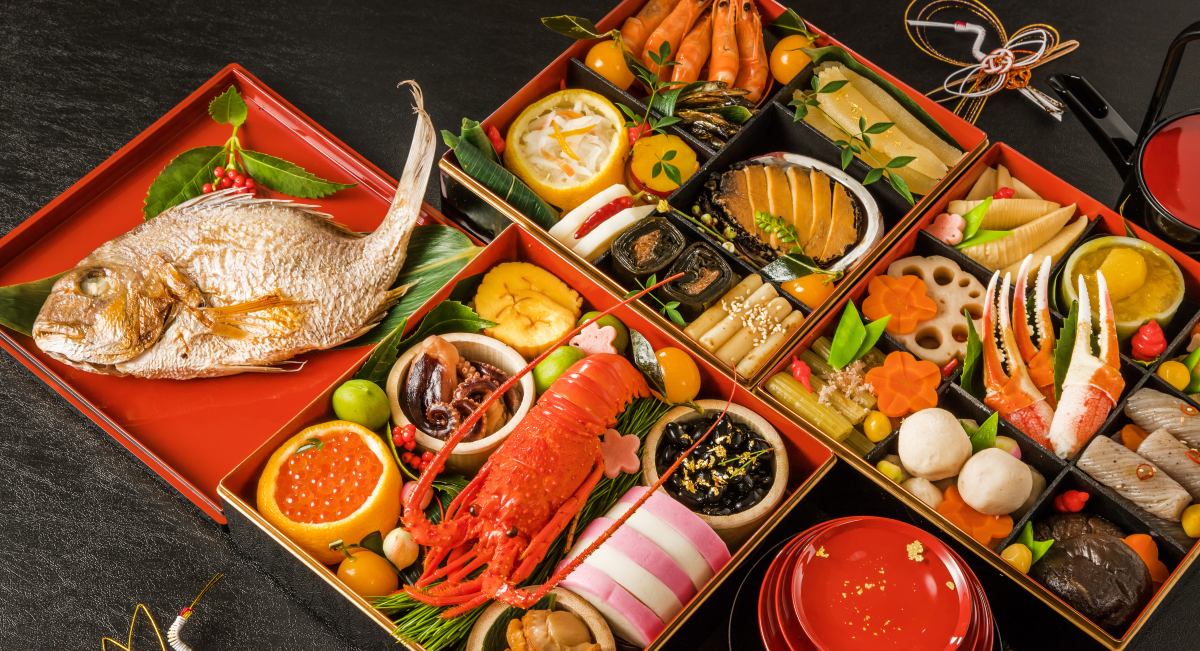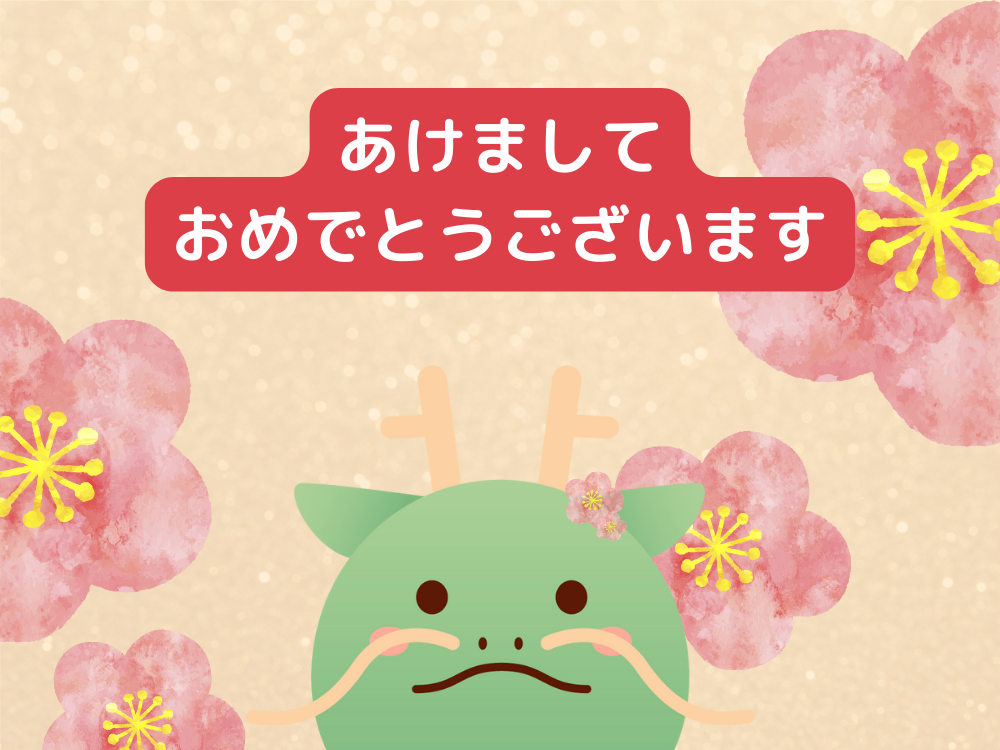How is everyone spending the New Year?
Japan is filled with the festive atmosphere of the New Year. It makes me stand a little taller.
In Japan, there is a tradition of eating a special dish called “Osechi Ryori” during the New Year.
In this post, I will introduce what exactly Osechi Ryori is, its history, and meaning and the wishes that go into each dish.
History of Osechi Ryori
Osechi Ryori is still a standard New Year’s dish today, but its history dates back to the Yayoi period (around the 10th century)!
When the calendar system was introduced to Japan from China during the Yayoi period, people began to make festive offerings called “Osechiku” to the gods at the change of seasons, following the Chinese custom, and to eat “Osechi” as a gift from the gods.
In the Heian period (710-1192), this custom of eating Osechi became a court event, and during the Edo period (1600-1868), it spread to ordinary households.
In addition, although Osechi is now a well-established New Year’s dish, at that time it was eaten at every of the five annual events called Gosechie (five festivals).
Osechi in Present Days
Osechi in present days is generally packed in stacked boxes as shown in the photo. Although it is also considered basic to pack the food in a 5-tiered boxes (Jubako), recently more and more families are preparing 3-tiered or 1-tiered Osechi because the quantity is too large for the number of family members.
From the top, the stacked boxes are called “Ichi-no-ju,” “Ni-no-ju,” “San-no-ju,” “Yo-no-ju,” and “Go-no-ju.” Look at the fourth tier is not called “Shi-no-ju”. Fourth is usually read “Shi” in Japanese, but because “Shi” is associated with “death,” the fourth tier is given the alternative reading “Yo”.

Meaning of Each Osechi Dish
Osechi dishes have been popular in Japan since ancient times, and each dish has its own meaning. Here are the wishes behind the Osechi dishes in the order of the stacked boxes.
Ichi-no-ju (First Tier)
The first tier mainly contains celebratory appetizers (Iwaizakana), which are accompaniments to alcoholic beverages, and “Kuchitori”, sweet dishes to be eaten with soup.
| Dish name | Description | Wish | Reason |
|---|---|---|---|
| Kazunoko | Salted herring roe | Perpetuation of descendants | Because Kazunoko has so many eggs. |
| Kuromame | Sweetened black beans | to be able to work “Mamemameshiku” (faithfully) and energetically. | Word play with “Mame” |
| Tazukuri | Dried Japanese anchovy | Abundant harvest | Because Japanese anchovies were used as fertilizer for the fields in the past. |
| Tatakigobo | burdock seasoned with sesame | Abundant harvest | Because it resembles a black Zuicho, a symbol of a good harvest. |
| Datemaki | Swirled egg omelet | More knowledge | Because it looks like the shape of an old scroll |
| Kurikinton | Chestnut stewed in soy sauce and sugar with sweet potato paste | Save money | Because the dish color is bright gold and “Kinton” can be read as a mass of gold |
| Kobumaki | Herring wrapped in seaweed and tied with Kanpyo (dried gourd) | Celebration | Because Kobu (seaweed) has the same sound with “Yorokobu” (to be pleased) |
| Kohaku-kamaboko | Pair of red and white cut fish cakes (sometimes in the shape of a peacock) | Red for protection from evil and joy, white for holiness. | Because it is a happy color pair |
Ni-no-ju (Second Tier)
The second tier is often followed by a “grilled” seafood dish, as shown below (I love the yellowtail teriyaki).
| Dish name | Description | Wish | Reason |
|---|---|---|---|
| Grilled shrimp | Grilled shrimp with salt | Long life | Because the shrimp’s back is bent like a old person |
| Grilled sea beam | Grilled sea beam with salt | Celebration | Because Tai (sea beam) has the same sound with “Medetai” (happy) |
| Yellowtail teriyaki | Grilled yellowtail with teriyaki sauce | Success in work | Because yellowtail are called by different names as they get bigger |
San-no-ju (Third Tier)
The third tier usually includes vinegared dishes for palate-cleansing.
| Dish name | Description | Wish | Reason |
|---|---|---|---|
| Kikka-kabu | Vinegared turnip cut to resemble a chrysanthemum flower | Ward off evil spirits | Because chrysanthemums are believed to have the power to ward off evil spirits |
| Kohaku-namasu | Vinegared shredded daikon radish and carrot | Celebration Stable family business | Red and white are auspicious colors, and daikon and carrot mean “stability” because they grow their roots |
Yo-no-ju (Fourth Tier)
The Fourth tier usually include stewed mountain vegetables. Root vegetables are usually stewed in Chikuzen-ni (boiled and seasoned vegetables) along with chicken and other ingredients. Since many ingredients are stewed together, it also has a meaning such as all family members get along well together.
| Dish name | Description | Wish | Reason |
|---|---|---|---|
| Chikuzen-ni | Lotus root, carrot, daikon radish, shiitake mushroom, burdock root, etc. simmered with chicken | Foreseeable future, long life, stable family business, and family unity | Because lotus root has a hole in it (foreseeable), shiitake mushrooms resemble the shell of a turtle (long life), burdocks have extensive roots (stable), and Chikuzen-ni is made by simmering various things together (unite) |
| Shironi | Sweetened black beans | Perpetuation of descendants | Because one seed potato produces many potatoes |
| Tazuna-konnyaku | Simmered twisted konnyaku | Good match and happy marriage | Because a knot is formed in the twisted konnyaku and the Japanese word for a knot “Musubu” means matchmaking |
Go-no-ju (Fifth Tier)
The fifth tier is also called the “Hikae-no-ju”, meaning an antechamber, and is usually left empty. It is said that by daring to leave it empty, it means that there is room for prosperity.
Summary
How do you enjoy the story of Osechi? I hope you have learned that Osechi is not only a gorgeous dish to be eaten at the beginning of the year, but also a traditional dish in which each dish has its own meaning and contains wishes for the new year.
In addition to Osechi, there are many other traditional Japanese New Year’s events and traditions.
Please take a look at the post below to learn more about what people do on New Year’s Day in Japan!
Hope everyone have a wonderful New Year’s Day~!


